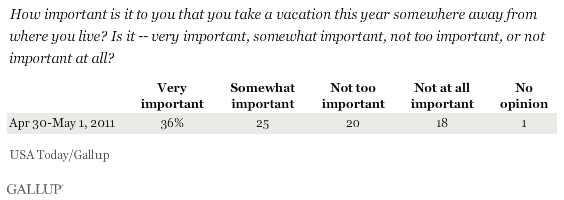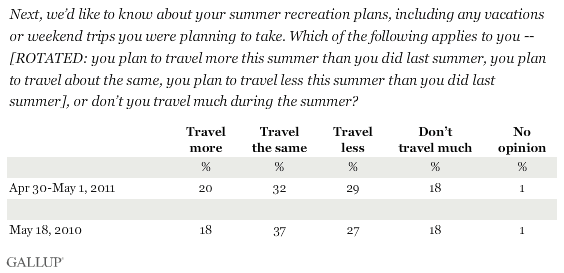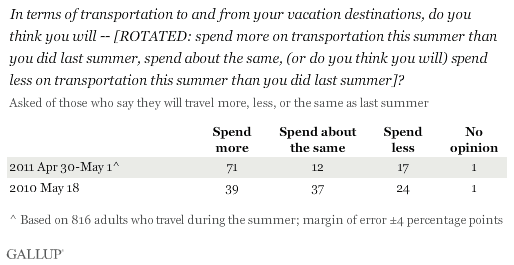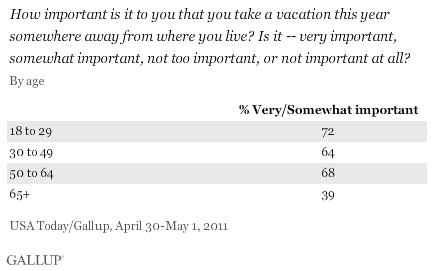PRINCETON, NJ -- More than 6 in 10 Americans say taking a vacation away from where they live this year is important, although most anticipate they will have to spend more on transportation costs than they did last summer.

Twenty-nine percent of Americans interviewed as part of the April 30-May 1 USA Today/Gallup poll said they will "travel less" this summer, about the same as said that last year at this time (27%) -- despite the spike in the price of gas.

The reality of higher gas prices is evident for traveling Americans. Seventy-one percent of Americans who will be traveling this summer predict they will spend more on transportation. This compares with 39% who said they would spend more on transportation last May, when the average price of gas in the U.S. was about $2.80 per gallon.

Vacations Less Important for Those 65 and Older
For many people, vacations are an opportunity to get away from work, which helps explain why Americans 65 years of age and older give much lower importance ratings to vacations away from home than do those younger than 65.

Working Americans and those with the highest incomes are also among the most likely to say vacations are important.
Implications
These results suggest that higher gas prices and airfares will not stand in the way of many Americans' vacation plans this summer.
It may be that Americans are becoming inured to high gas prices. Gallup recently found that only 8% of Americans mentioned gas prices as the most important problem facing the country today. This is up from last year at this time, but remains well below the 25% of Americans who said this was the top problem facing the country back in June 2008, when gas prices spiked over $4 a gallon.
Survey Methods
Results for this USA Today/Gallup poll are based on telephone interviews conducted April 30-May 1, 2011, on the Gallup Daily tracking survey, with a random sample of 1,019 adults, aged 18 and older, living in all 50 U.S. states and the District of Columbia.
For results based on the total sample of national adults, one can say with 95% confidence that the maximum margin of sampling error is ±4 percentage points.
Interviews are conducted with respondents on landline telephones and cellular phones, with interviews conducted in Spanish for respondents who are primarily Spanish-speaking. Each sample includes a minimum quota of 400 cell phone respondents and 600 landline respondents per 1,000 national adults, with additional minimum quotas among landline respondents for gender within region. Landline telephone numbers are chosen at random among listed telephone numbers. Cell phone numbers are selected using random-digit-dial methods. Landline respondents are chosen at random within each household on the basis of which member had the most recent birthday.
Samples are weighted by gender, age, race, Hispanic ethnicity, education, region, adults in the household, and phone status (cell phone only/landline only/both, cell phone mostly, and having an unlisted landline number). Demographic weighting targets are based on the March 2010 Current Population Survey figures for the aged 18 and older non-institutionalized population living in U.S. telephone households. All reported margins of sampling error include the computed design effects for weighting and sample design.
In addition to sampling error, question wording and practical difficulties in conducting surveys can introduce error or bias into the findings of public opinion polls.
View methodology, full question results, and trend data.
For more details on Gallup's polling methodology, visit www.gallup.com.
